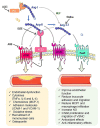Role of Renin-Angiotensin System Components in Atherosclerosis: Focus on Ang-II, ACE2, and Ang-1-7
- PMID: 33013457
- PMCID: PMC7494970
- DOI: 10.3389/fphys.2020.01067
Role of Renin-Angiotensin System Components in Atherosclerosis: Focus on Ang-II, ACE2, and Ang-1-7
Abstract
Atherosclerosis is the leading cause of vascular disease worldwide and contributes significantly to deaths from cardiovascular complications. There is a remarkably close relationship between atherosclerotic plaque formation and the activation of renin-angiotensin system (RAS). However, depending on which RAS pathway is activated, pro- or anti-atherogenic outcomes may be observed. This brief review focuses on the role of three of the most important pieces of RAS axis, angiotensin II (Ang-II), angiotensin converting enzyme type 2 (ACE2), and angiotensin 1-7 (Ang-1-7) and their involvement in atherosclerosis. We focused on the effects of these molecules on vascular function and inflammation, which are important determinants of atherogenesis. Furthermore, we highlighted potential pharmacological approaches to treat this disorder.
Keywords: angiotensin 1–7; angiotensin II; angiotensin converting enzyme type 2; atherosclerosis; endothelial dysfunction; inflammation.
Copyright © 2020 Silva, França-Falcão, Calzerra, Luz, Gadelha, Balarini and Queiroz.
Figures


Similar articles
-
Deletion of angiotensin-converting enzyme 2 promotes the development of atherosclerosis and arterial neointima formation.Cardiovasc Res. 2014 Feb 1;101(2):236-46. doi: 10.1093/cvr/cvt245. Epub 2013 Nov 4. Cardiovasc Res. 2014. PMID: 24193738
-
Intrarenal alterations of the angiotensin-converting enzyme type 2/angiotensin 1-7 complex of the renin-angiotensin system do not alter the course of malignant hypertension in Cyp1a1-Ren-2 transgenic rats.Clin Exp Pharmacol Physiol. 2016 Apr;43(4):438-49. doi: 10.1111/1440-1681.12553. Clin Exp Pharmacol Physiol. 2016. PMID: 26833491
-
Perspectives for angiotensin profiling with liquid chromatography/mass spectrometry to evaluate ACE/ACE2 balance in endothelial dysfunction and vascular pathologies.Pharmacol Rep. 2015 Aug;67(4):778-85. doi: 10.1016/j.pharep.2015.03.017. Epub 2015 Apr 11. Pharmacol Rep. 2015. PMID: 26321281 Review.
-
ACE2 activity was increased in atherosclerotic plaque by losartan: Possible relation to anti-atherosclerosis.J Renin Angiotensin Aldosterone Syst. 2015 Jun;16(2):292-300. doi: 10.1177/1470320314542829. Epub 2014 Jul 27. J Renin Angiotensin Aldosterone Syst. 2015. PMID: 25070352
-
ACE inhibition, ACE2 and angiotensin-(1-7) axis in kidney and cardiac inflammation and fibrosis.Pharmacol Res. 2016 May;107:154-162. doi: 10.1016/j.phrs.2016.03.018. Epub 2016 Mar 17. Pharmacol Res. 2016. PMID: 26995300 Review.
Cited by
-
Effects of Statins on Renin-Angiotensin System.J Cardiovasc Dev Dis. 2021 Jul 9;8(7):80. doi: 10.3390/jcdd8070080. J Cardiovasc Dev Dis. 2021. PMID: 34357323 Free PMC article. Review.
-
Circadian rhythms of risk factors and management in atherosclerotic and hypertensive vascular disease: Modern chronobiological perspectives of an ancient disease.Chronobiol Int. 2023 Jan;40(1):33-62. doi: 10.1080/07420528.2022.2080557. Epub 2022 Jun 27. Chronobiol Int. 2023. PMID: 35758140 Free PMC article. Review.
-
Male bias in ACE2 basic science research: missed opportunity for discovery in the time of COVID-19.Am J Physiol Regul Integr Comp Physiol. 2021 Jun 1;320(6):R925-R937. doi: 10.1152/ajpregu.00356.2020. Epub 2021 Apr 13. Am J Physiol Regul Integr Comp Physiol. 2021. PMID: 33848207 Free PMC article. Review.
-
Sex Difference of Alcoholic Hypertension: Mechanism and Targeted Therapy.Curr Hypertens Rep. 2025 Jun 10;27(1):17. doi: 10.1007/s11906-025-01334-7. Curr Hypertens Rep. 2025. PMID: 40493257 Review.
-
An update on angiotensin-converting enzyme 2 structure/functions, polymorphism, and duplicitous nature in the pathophysiology of coronavirus disease 2019: Implications for vascular and coagulation disease associated with severe acute respiratory syndrome coronavirus infection.Front Microbiol. 2022 Nov 28;13:1042200. doi: 10.3389/fmicb.2022.1042200. eCollection 2022. Front Microbiol. 2022. PMID: 36519165 Free PMC article. Review.
References
-
- Anguiano L., Riera M., Pascual J., Valdivielso J. M., Barrios C., Betriu A., et al. . (2016). Circulating angiotensin converting enzyme 2 activity as a biomarker of silent atherosclerosis in patients with chronic kidney disease. Atherosclerosis 253, 135–143. 10.1016/j.atherosclerosis.2016.08.032, PMID: - DOI - PubMed
-
- Canault M., Leroyer A. S., Peiretti F., Lesèche G., Tedgui A., Bonardo B., et al. . (2007). Microparticles of human atherosclerotic plaques enhance the shedding of the tumor necrosis factor-alpha converting enzyme/ADAM17 substrates, tumor necrosis factor and tumor necrosis factor receptor-1. Am. J. Pathol. 171, 1713–1723. 10.2353/ajpath.2007.070021, PMID: - DOI - PMC - PubMed
-
- Canault M., Peiretti F., Kopp F., Bonardo B., Bonzi M. F., Coudeyreet J. C., et al. . (2006). The TNF alpha convert-ing enzyme (TACE/ADAM17) is expressed in the atherosclerotic lesions of apolipoprotein E-deficient mice: possible contribution to elevated plasma levels of soluble TNF alpha receptors. Atherosclerosis 187, 182–191. 10.1016/j.atherosclerosis.2005.08.031, PMID: - DOI - PubMed
Publication types
LinkOut - more resources
Full Text Sources
Miscellaneous

